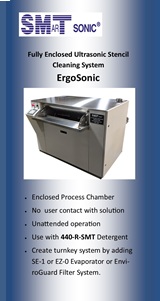|

|
|
| Ask the Experts | |||||||
|
|||||||
|
February 14, 2011 - Updated February 14, 2011 - Originally Posted Soldering to Hard GoldWhat is the best practice for automated assembly of surface mount components on bare PCBs that were fabricated entirely with hard gold finish? The boards are plated with 30 millionths of gold over 150 millionths of nickel. We use both leaded and lead-free processes. Would convection, vapor phase or any other method be recommended to ensure the most reliable joints? Would reliability be the roughly the same if we used PCBs with standard tin/solder plating? R. D. |
|||||||
| Expert Panel Responses | |||||||
|
In response to your inquiry; I would like to talk about point soldering for this application, however soldering of SMT components with this method would depend upon the pitch and number of components. If the component / lead count is high or pitch is very fine you may want to consider other methods of soldering unless those have failed you. If a point to point system could be used, (Hot Iron or Diode Laser) PROMATION would also suggest considering adding a hot air assist feature to the soldering end effector. Localized preheating of the joint first greatly aids in the ability to solder through thermally challenged materials (Tin Lead or Lead Free). Depending upon the component(s) most hot iron systems work well until the tip size reaches 0.8 mm, some 0.6 mm. Smaller pads should consider a diode laser which can be focused to a smaller beam size. Hot iron's can be programmed to dwell on the joint for a period of time to off set any thermal planes prior to introducing solder. This effects cycle time. If a preheat assist feature is used, this too helps off set any thermal planes and in some applications the preheat can be initially focused on the first joint and then move to the next joint while the first joint is being soldered. This function allows for both preheating and soldering to occur together after the first joint. Localized preheat will also decrease soldering times and allow the solder to flow freely throughout the joint or pad. Unless sensitive components exist in the area Custom tips may also be available for soldering after preheating. For fine pitch soldering a diode laser should be considered, however, it is not good to allow a laser to dwell on a joint area too long. This heat source is not good for preheating a joint or pad before soldering. Again, use a preheat assist feature to get the pad up to 100C before soldering and the result should be very good. The final consideration would be to place solder paste before soldering, go with an automatic solder feeder or both. This would depend upon how much solder your application required. As with any challenging application, have samples soldered for you. Hope this helps.
President and CEO PROMATION, Inc. Mr Goldberg has practical experience in production line layout, process flow and cycle rate analysis. He knows how to avoid bottle necks and most related PCB or pallet handling questions.
It takes special knowledge of chemical deoxidants, entirely different kinds of solders (not alloys), and special process expertise in order to successfully solder with laser energy. See http://www.analog-tech.com/Solder%20Ball%20Attachment%20Using%20Laser%20Soldering.pdf
Advanced Engineer/Scientist General Dynamics Richard D. Stadem is an advanced engineer/scientist for General Dynamics and is also a consulting engineer for other companies. He has 38 years of engineering experience having worked for Honeywell, ADC, Pemstar (now Benchmark), Analog Technologies, and General Dynamics.
Assuming that 30 millionth of an inch are 0.76um Au over 3.8um Ni, the thickness of gold would be quite high. This might lead to gold embrittlement. You can either decrease the thickness of gold and chose selectively plated gold or you might want to try to increase the reflow times at a higher temperature. All of the soldering methods might give the same potentially poor brittle results. However, the longer the solder is molten the more likely it is that all of the gold will be dissolved what should be avoided. The reliability may be improved by using a thinner gold plating or using the Sn/Pb finish on the printed circuit board.
Marketing 360-Biz Douglass Dixon is the Chief Marketing Officer for 360 BC Group, a marketing agency with offices throughout the US. 360 BC specializes in consulting and implementing successful marketing programs that utilize the latest in marketing, sales and technology strategies. As an electronics veteran, Dixon has worked in the industry for over 30 years for companies like Henkel, Universal Instruments, Camelot Systems, and Raytheon. Dixon's electronics industry experience includes a broad skill set that includes engineering, field service, applications, product management and marketing communications expertise.
|
|||||||
| Submit A Comment | |||||||
|
Comments are reviewed prior to posting. You must include your full name to have your comments posted. We will not post your email address. |
|
Free Newsletter Subscription
Circuitnet is built for professionals who bear the responsibility of looking ahead, imagining the future, and preparing for it. Insert Your Email Address |
|

|




